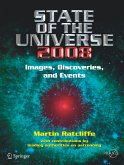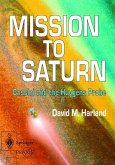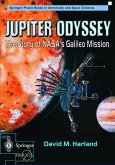Like the movie "Apollo 13" and the book on which it was based, Neptune: The Planets, Rings and Satellites tells the real story of the Voyager Mission to the outer planets from the point of view of the people who were there. It shows clearly the planning, excitement and major advances in our knowledge of Neptune and its system associated with the highly successful Voyager Mission and will remain a definitive description of Neptune for decades to come.
From the reviews:
"Neptune is written by two members of the JPL team that was responsible for the mission and is intended to give a comprehensive popular record of the Voyager 2 spacecraft and its pioneering mission... The difficulties of managing a complex programme over several years, especially given the long cruises between hectic encounters are apparent... This is an enjoyable read for those interested in the outer solar system and its exploration."
-- ASTRONOMY NOW
"The book follows the general format and content of Uranus: The Planet, Rings and Satellites, written as a part of the Wiley-Praxis Series in Astronomy and Astrophysics. It is written in a language and style more accessible and understandable to the 'non-expert'. ... the book will be of interest primarily to students and those with a general interest in the solar system ... ." (Milan Bursa, Earth, Moon and Planets, Vol. 123, 2002)
"Neptune is written by two members of the JPL team that was responsible for the mission and is intended to give a comprehensive popular record of the Voyager 2 spacecraft and its pioneering mission. ... Although technical, it is written for the non-expert reader and is well illustrated with line drawings, black and white images, and a few colour plates in the centre of the book. This is an enjoyable read for those interested in the outer solar system and its exploration." (Glen Thomas, Astronomy Now, February, 2003)
"A superb book, is the best description of Neptune, The Planet, rings and satellites. ... For anyone looking for a book to help them with a project or presentation on this distant blue gem then this book is certainly the one. ... With its authors Miner / Wessen both in on the projects from the beginning it is a first rate account of what it took to get the Voyagers off the drawing boards and out into deep space." (Tony C. O'Connell, Astronomy & Space, December, 2002)
"Miner and Wessen have written aclear and readable account of the Voyager 2 mission to Neptune. ... this text is squarely directed at the interested 'non-expert'. ... the authors provide a readable description of how NASA's Deep Space Network was upgraded to meet the challenge. ... the authors have done a good job in collecting material from many sources ... . I think that the authors have succeeded well in their stated intention of presenting the Voyager science and technology to a non-technical audience." (Nick James, Journal of the British Astronomical Association, Vol. 112 (5), 2002)
"Both Ellis Miner and Randii Wessen were mission scientists on the Jet Propulsion Laboratory Voyager team. This has given their book a special 'spacey' flavour. ... Fascinating details of engineering and operational procedures abound. In Neptune, the authors have produced a well-balanced cocktail that combines an up-to-date review of our scientific knowledge ... with a first-hand insight into the workings and instrumentation of the Voyager 2 spacecraft. ... an excellent introduction to the eponymous planet. ... the book is well referenced and profusely illustrated." (David W. Hughes, The Observatory, Vol. 122 (1170), 2002)
"Neptune is written by two members of the JPL team that was responsible for the mission and is intended to give a comprehensive popular record of the Voyager 2 spacecraft and its pioneering mission... The difficulties of managing a complex programme over several years, especially given the long cruises between hectic encounters are apparent... This is an enjoyable read for those interested in the outer solar system and its exploration."
-- ASTRONOMY NOW
"The book follows the general format and content of Uranus: The Planet, Rings and Satellites, written as a part of the Wiley-Praxis Series in Astronomy and Astrophysics. It is written in a language and style more accessible and understandable to the 'non-expert'. ... the book will be of interest primarily to students and those with a general interest in the solar system ... ." (Milan Bursa, Earth, Moon and Planets, Vol. 123, 2002)
"Neptune is written by two members of the JPL team that was responsible for the mission and is intended to give a comprehensive popular record of the Voyager 2 spacecraft and its pioneering mission. ... Although technical, it is written for the non-expert reader and is well illustrated with line drawings, black and white images, and a few colour plates in the centre of the book. This is an enjoyable read for those interested in the outer solar system and its exploration." (Glen Thomas, Astronomy Now, February, 2003)
"A superb book, is the best description of Neptune, The Planet, rings and satellites. ... For anyone looking for a book to help them with a project or presentation on this distant blue gem then this book is certainly the one. ... With its authors Miner / Wessen both in on the projects from the beginning it is a first rate account of what it took to get the Voyagers off the drawing boards and out into deep space." (Tony C. O'Connell, Astronomy & Space, December, 2002)
"Miner and Wessen have written aclear and readable account of the Voyager 2 mission to Neptune. ... this text is squarely directed at the interested 'non-expert'. ... the authors provide a readable description of how NASA's Deep Space Network was upgraded to meet the challenge. ... the authors have done a good job in collecting material from many sources ... . I think that the authors have succeeded well in their stated intention of presenting the Voyager science and technology to a non-technical audience." (Nick James, Journal of the British Astronomical Association, Vol. 112 (5), 2002)
"Both Ellis Miner and Randii Wessen were mission scientists on the Jet Propulsion Laboratory Voyager team. This has given their book a special 'spacey' flavour. ... Fascinating details of engineering and operational procedures abound. In Neptune, the authors have produced a well-balanced cocktail that combines an up-to-date review of our scientific knowledge ... with a first-hand insight into the workings and instrumentation of the Voyager 2 spacecraft. ... an excellent introduction to the eponymous planet. ... the book is well referenced and profusely illustrated." (David W. Hughes, The Observatory, Vol. 122 (1170), 2002)








